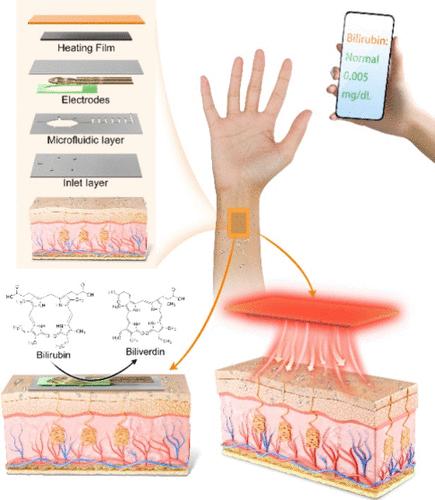基于热刺激的自主出汗可穿戴胆红素传感平台
IF 6.7
1区 化学
Q1 CHEMISTRY, ANALYTICAL
引用次数: 0
摘要
胆红素(Bilirubin, BR)是黄疸、肝炎等肝脏疾病的重要生物标志物,具有多种生理功能和健康意义。它通常通过血液检测。汗液可穿戴设备提供了一种无创监测BR的方法,但在稳定性和选择性方面面临挑战,并且对于久坐的个体来说,获得足够的汗液是困难的。本研究介绍了一种创新的自主出汗可穿戴平台,用于无创监测胆红素水平。该平台包括用于控制汗液提取的自动加热膜,用于高效汗液采样的皮肤界面微流控系统,以及用于精确BR传感的柔性电极。该平台利用MXene/MWCNT,可以直接在皮肤上精确灵敏地进行痕量BR的电化学检测。激光雕刻柔性加热膜和微流体系统的集成允许控制和可靠的汗液采样,使生物标志物检测变得容易。该平台展示了有效的汗液采样和准确的BR检测,展示了其在无创健康监测应用中的潜力。它的设计和功能为连续和方便地监测BR水平提供了一个有前途的解决方案,为汗液生物标志物分析提供了一种新的方法。本文章由计算机程序翻译,如有差异,请以英文原文为准。

Autonomous Sweating Wearable Platform for Bilirubin Sensing Based on Thermal Stimulation
Bilirubin (BR), with diverse physiological functions and health implications, is a vital biomarker related to liver diseases such as jaundice and hepatitis. It is generally tested by blood. Sweat wearable devices provide a noninvasive way to monitor BR but face challenges in stability and selectivity, and acquiring sufficient sweat is difficult for sedentary individuals. This study introduces an innovative autonomous sweating wearable platform for noninvasive monitoring of bilirubin levels. The platform incorporates an autonomous heating film for controlled sweat extraction, a skin-interfaced microfluidic system for efficient sweat sampling, and a flexible electrode for accurate BR sensing. The utilization of MXene/MWCNT in the platform enables precise and sensitive electrochemical detection of trace-level BR directly on the skin. The integration of a laser-engraved flexible heating film and a microfluidic system allows for controlled and reliable sweat sampling, enabling easy biomarker detection at rest. The platform demonstrates effective sweat sampling and accurate BR detection, showcasing its potential for noninvasive health monitoring applications. Its design and functionality offer a promising solution for continuous and convenient monitoring of BR levels, providing a novel approach to sweat biomarker analysis.
求助全文
通过发布文献求助,成功后即可免费获取论文全文。
去求助
来源期刊

Analytical Chemistry
化学-分析化学
CiteScore
12.10
自引率
12.20%
发文量
1949
审稿时长
1.4 months
期刊介绍:
Analytical Chemistry, a peer-reviewed research journal, focuses on disseminating new and original knowledge across all branches of analytical chemistry. Fundamental articles may explore general principles of chemical measurement science and need not directly address existing or potential analytical methodology. They can be entirely theoretical or report experimental results. Contributions may cover various phases of analytical operations, including sampling, bioanalysis, electrochemistry, mass spectrometry, microscale and nanoscale systems, environmental analysis, separations, spectroscopy, chemical reactions and selectivity, instrumentation, imaging, surface analysis, and data processing. Papers discussing known analytical methods should present a significant, original application of the method, a notable improvement, or results on an important analyte.
 求助内容:
求助内容: 应助结果提醒方式:
应助结果提醒方式:


